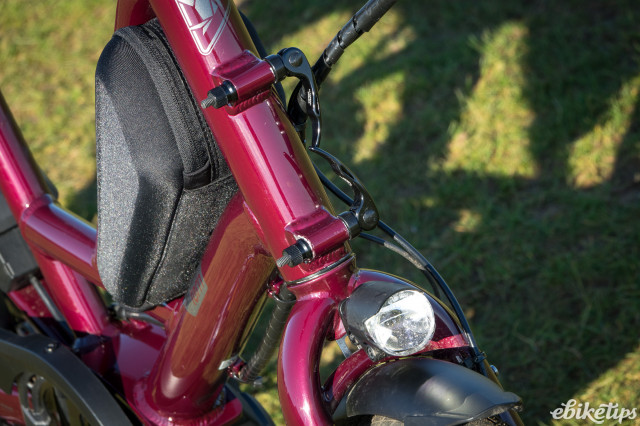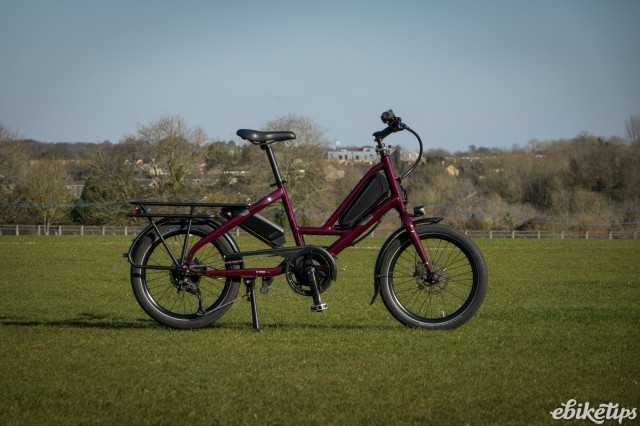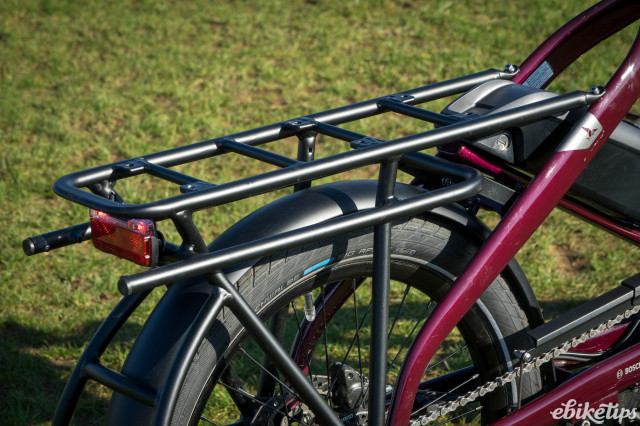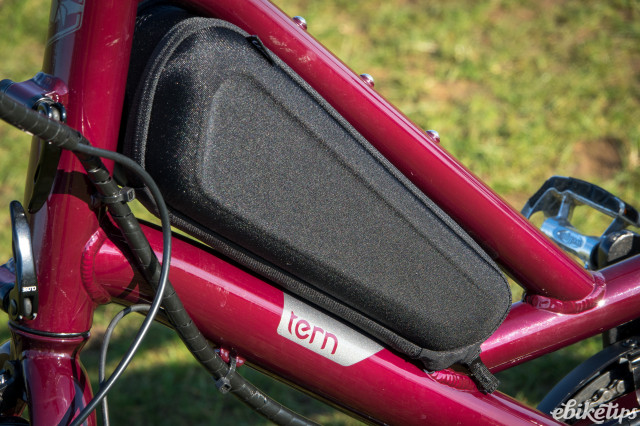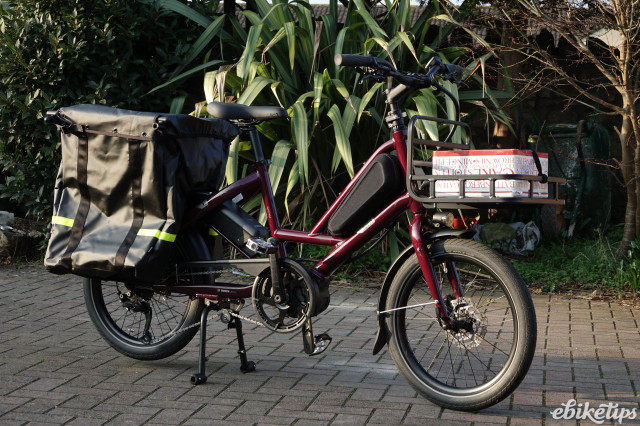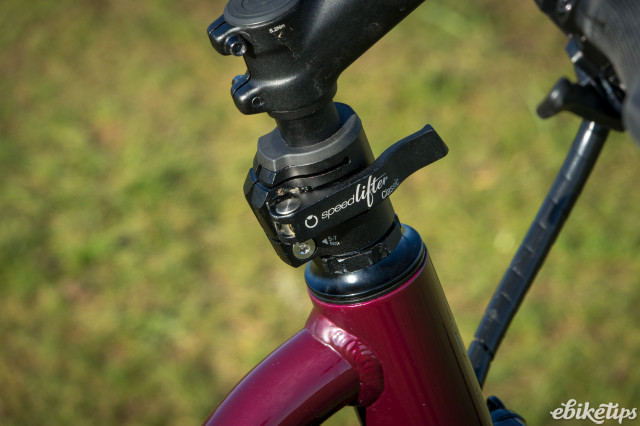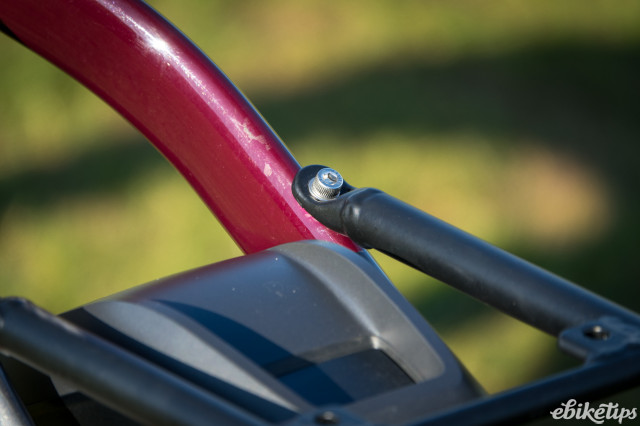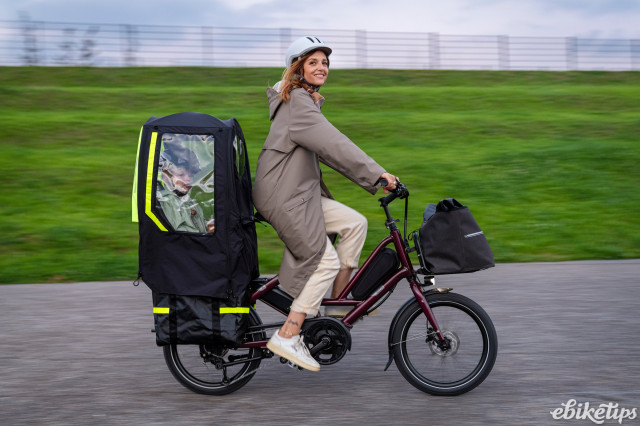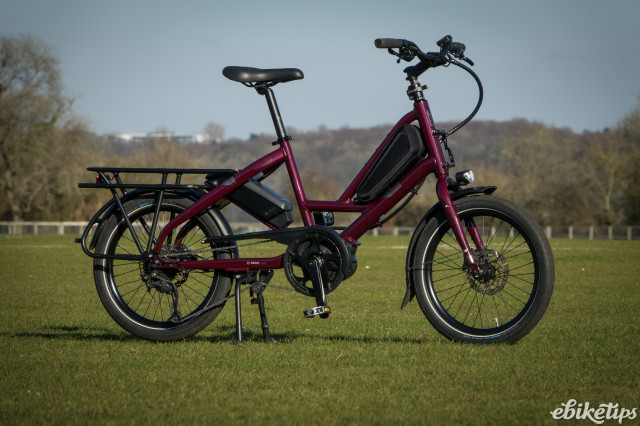Tern Quick Haul P9
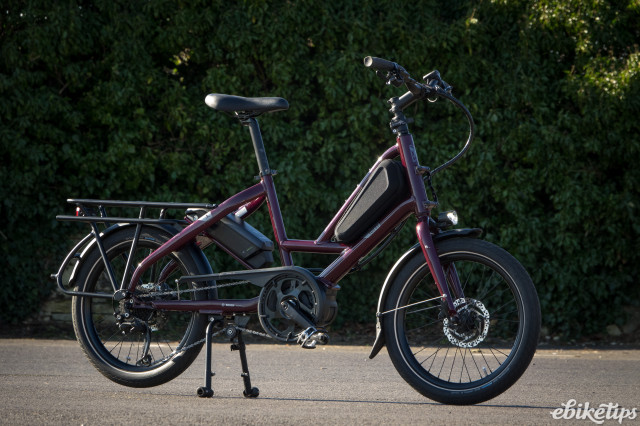
Overview
- Huge range of cargo and passenger options
- Excellent motor and transmission
- Small footprint makes it easy to store
- No frame lock as standard
- Kickstand a bit flimsy for loading bigger kids
Tern’s Quick Haul is the company’s attempt to bring cargo biking to the masses – well, more of the masses, anyway – with a bike that takes loads of the versatility of the GSD and HSD models and squeezes it into a better value package. And you know what? It’s broadly a success. There’s lots to like about the Quick Haul, and nearly all of the compromises are sensible ones. It’s a great step up from a standard city bike if you’ve got pockets deep enough: it’s still not cheap.
A bit of Tern history before we dive into this new model. The original Tern GSD was a bike that we first got our hands on in 2017 at the Eurobike show, and ever since then it’s been a firm favourite. We’re on the second generation of that bike now, but Tern pretty much nailed it right from the off. Built around a longtail frame, small wheels and a powerful Bosch motor it was a cargo bike that was instrumental in shifting thinking. You could take two kids on it, or give a friend a lift, or do the weekly shop, and it was no bigger than a normal city bike. Plus, you could stand it on its end, so you could even store it in a flat. It’s pretty much our favourite e-bike round these parts, and has been for a long while.
Step forward two years and at the same show we got our first miles in on the HSD, the GSD’s smaller cousin. With less carrying capacity than the GSD – but still plenty – The HSD was also well received on ebiketips. When we reviewed it at the end of 2019 we called it “A supremely useful cargo bike that’s a great day-to-day city companion”. It’s still a pretty expensive bike though, with builds currently starting at £3,600 and rising to £5,400 for the top-end model.
If you want cheaper cargo bikes then you can certainly get them: the Rad Power Rad Wagon, for example, is well under two grand, and the smaller RadRunner is even cheaper. And while both of those are great bikes, and killer value, they may lack the power you need for some of the things you’ll want to do, especially if you live somewhere hilly. The Quick Haul is Tern's answer to people who want the versatility of the HSD or GSD, with the power of a Bosch motor, but at a lower price. The new bike comes in two versions, the Quick Haul P9 and D8, which retail for £3,000 and £2,800 respectively.
Like its siblings, the Tern Quick Haul is an alloy-framed, small-wheeled cargo bike that’s predominantly designed to be loaded at the rear. The bike can carry 150kg in total, and the Atlas Q rear rack can handle 50kg. Like the HSD, it’s bolted on to the frame, rather than being an integral part of the structure as it is on the GSD. That means you can’t give lifts to big grown ups but there’s plenty of capacity for A child in a seat, or a bigger kid using one of the other rear-rack-mounted options. There’s a double mount point on the headtube too, which allows you to fit Tern’s Hauler or Transporteur rack up front for up to 20kg carrying capacity.
The rear rack is designed to work with Tern’s excellent Cargo Hold 37 panniers, and it uses the same four-point top mounting system as the HSD, which means that plenty of the stuff that Tern already makes will fit the new bike. You can fit the Clubhouse Mini bars for passengers, and inside that a Yepp bike seat for toddlers or a seat pad for an older child that can hang on by themselves. There are new Sidekick Stirrups available for the Quick Haul to keep your passenger’s feet protected. The Clubhouse Mini can be fitted with the Storm Box, which gives a big, waterproof storage area across the rack and down the sides, and is also the base for the Storm Shield Mini, which is a weatherproof tent for carting a child around in the worst weather. If you don’t need that much carrying capacity then you can fit the soft crate, which just spans the width of the rack, and you can add a dog cover to that for carrying your (reasonably compact) canine friend.
Our bike came fitted with the Quick Haul Glove Box, which fits inside the frame and is a useful extra storage space for nick nacks. There’s also a branding plate available for that space in the frame; Tern sees a significant market for this bike as a smaller, cheaper last mile option for city businesses. Anyway, assuming you don’t need to cart around two extra people or move a fridge freezer, Tern probably has you covered with one of the bolt-ons. It’s worth noting that piling on the accessories can seriously bump up the price of the bike. You can use some standard panniers for a cheap carrying option, and you may already have some, but the (excellent) Tern panniers are going to set you back an extra £200, and if you wanted, say, the Storm Shield Mini (which also requires the Clubhouse Mini and the Storm Box Mini) and a rack at the front, then you’re adding over £700 to the base price of the bike.
That’s true of the other bikes in the range too, though, so you’re still saving at least £600 over an HSD whatever the extras. That’s a significant saving, so where’s it coming from? Well, across the board you can see that costs have been cut. Compared to the HSD P9, which uses the same Alivio 9-speed transmission, there’s no suspension fork, and no frame lock, which I have to say I did miss. The lights, wheels and brakes are lower spec too, and the Atlas rack is not quite as beefy. You don’t get the double telescopic seatpost, and you don’t get Tern’s excellent Andros adjustable stem; instead you get a Speedlifter steerer which allows you to change the handlebar height easily enough.
The Quick Haul will still stand on its end, but because there’s no folding mechanism in the steerer it’s not as compact, and the front wheel has a tendency to flail around a bit as there’s no righting mechanism on the steering. This happens when it’s on the kickstand too. For all that, you’re still getting buy-in to the great range of Tern accessories, and very solid spec: the Performance Line motor on our review Quick Haul is better than the Active Line Plus that you get on all but the most expensive HSD right now.
But what’s it like to ride? We’ve had a pre-production Quick Haul P9 for the last few weeks; it’s basically production spec save for a larger 500Wh battery. Firstly I turned it over to road.cc bike reviewer Jez Ash, who’s also a Tern GSD owner, to get some miles in. And here are his thoughts:
Jez Says: “If you want to get a Tern then the Quick Haul is a sensible way in. The cheaper gears and brakes are fine; the brakes are definitely less powerful than the Maguras on their more expensive bikes, but they're perfectly serviceable. Keeping the clever design and powerful Bosch motor at the heart of the bike is definitely the way to go.
“The usual Tern modus operandi is present even at this price point - lots of very well-designed accessories which (a bit like on your new Porsche) can really bump up the price if you tick the boxes. But also lots of as-standard smarts - mounting points all over the shop for bottles, cages, panniers, good mudguards, quality tyres and so on.
“You get a Speedlifter stem instead of Tern's own Andros articulating design - again, presumably an economy to get the price down. The bike also has a more upright seatpost than the HSD and the second-generation GSD, and as a consequence I found there's a narrower range of heights at which you can get a really good riding position. You can still get by if you’re especially short or tall, but you probably won't be quite as comfortable as on the more expensive bikes. At 1.90m I had no issues with saddle height but found the reach to the handlebars was a bit more cramped than I'd want for a long ride. No front suspension definitely affects ride quality, but it’s a sensible economy to get down to the price point, and you do get good tyres.
“The rack is bolted on, rather than an integral part of the frame – rated to 50kg – so fine for shopping, dog or child but not an adult (or at least not a full-sized one). I rode it the day after Storm Eunice when the wind was still gusting to around 40mph, and – for fun (and to keep my daughter dry) – put the ClubHouse and Stormshield on the back. I was expecting it to be a proper handful, but riding it was not overly dramatic. The only issue was remembering to park it pointing into the wind, otherwise the wind would blow it off its kickstand, which wasn't popular with my passenger. The kickstand is noticeably less stable than the GSD’s Atlas stand, and with an 18kg passenger it felt unstable.
“Some other economies have been made. The bar grips are cheaper and a bit less comfortable than the Ergon grips that you get on the HSD/GSD. The front light seems less good, although it may just be because it's mounted a lot lower, on the front mudguard rather than at bar height. Not really enough light for going quickly down a dark hill, but ample for around town and being seen.
“The Quick Haul is a really solid entry to the Tern range - if you only need to take one passenger then it could be all the cargo bike you need. It's twice the price of something like a RadPower RadRunner, so whether you want to spend that much more will probably depend on how much of a benefit the Bosch power is to you. Around Bath, the Tern flies up hills unladen, dispatching even steep hills with consummate ease. Bike weight at 22kg is much less than a GSD, so the assistance feels more powerful. We've got the more expensive of the 2 models; for £200 less you get the less powerful Active Line Plus motor. If you lived somewhere flatter then arguably you might not need all the power available here.”
I’ve also been riding the Quick Haul over the past two weeks, and my thoughts very much mirror Jez’s: If you want to get the Tern versatility and the Bosch motor but at a lower price point, then this new bike is a very well considered entry model. It’s plenty versatile enough that it’ll appeal to a wide range of riders. Like the HSD it’s not necessarily a bike that you buy to replace a car initially, but once you’ve got one you’ll realise that it can take over a huge range of shorter car journeys and be easier and more fun in the process. You can get a lot of stuff on it, and it’s very easy to live with. Even without standing it on its end it takes up very little space in the shed.
It’s a bit more fun to ride than the heavier GSD, and a bit easier to manhandle into tight spaces too. Like Jez, I’m tall, and I found the riding position shorter than I’d like. I asked Tern about the decision to use a more upright position, and here’s what they said:
"We really like the slack seat post angle on the HSD and GSD - that's why we do it - but it's not to everybody's taste. We designed the Quick Haul to have a feel much closer to a normal trekking/hybrid bike. We wanted riders to be able to jump on the Quick Haul and think, ‘this feels just like my other bike’.
“We designed the bike this way because one primary target customer for Quick Haul is the last mile delivery company and a lot of their riders would be coming from traditional trekking/hybrid bikes. Riders who prefer a slightly more aggressive riding position and who are in the middle of the bell curve in height, prefer the Quick Haul's geometry."
All well and good? Well, I can see the logic. But on the other hand riders in the middle of the bell curve could have the same riding position as they currently do even with a slacker seat tube, and taller and shorter riders would be better catered for, so I’m not entirely convinced it’s not more of an aesthetic thing. But it’s not a deal breaker; we’ve had riders from about 1.65m to 1.9m on the bike with no issues.
Like the HSD before it, you don’t have to think of the Quick Haul as a cargo bike. If you’re on board the GSD then you’re always aware you’ve got some hauling capacity behind you, but the Quick Haul looks and behaves like a city bike until you want it to be a bit more versatile. With the fold-flat panniers fitted it’s compact and pretty light, but still with the carrying capacity and the motor power to get a pretty big grocery shop up a pretty steep hill, should you want to. It’s that sort of versatility that it really scores highly for. With the Club House and Storm Box it’s more obviously a load carrier but it’s still pretty compact, and the Storm Box is a particular favourite of mine: lots and lots of fully waterproof space you can just sling stuff in. I can see that being a popular last-mile option for working riders.
At £3,000 – but realistically at least £3,200, assuming you want to make use of Tern’s great accessories – the Quick Haul P9 still isn’t cheap. But it’s a more versatile bike than something like the excellent Cube Compact Sport Hybrid and now at least is playing in the same ballpark, where the HSD is a league above. That Cube has a bigger battery and slightly better transmission for £100 less, but lacks the Tern’s ability to turn into a serious load lugger when the need arises. If you don’t need the punch of the Performance Line motor where you live then the D8 build, with an Active Line Plus unit, will save you a further £200. For carting loads round Bath, the 65Nm Performance Line motor is the minimum spec I’d want, and for me the better motor and transmission are well worth the extra anyway.
Overall the Quick Haul is a really easy bike to get on with, and if you’re looking to replace car journeys with bike journeys it makes a solid case for your cash. It’ll do pretty much anything the HSD will do, for significantly less, and the price puts it in more of a straight fight with standard city bikes, a fight it’s well-equipped to win. It’s not as good as the GSD, which remains my favourite bike of the three, even with the hefty price tag. But it’s an excellent bike for the money and easy to recommend.
4 comments
Bosch's technical data suggests the difference between the performance of the various drive units essentially boils down to max torque and the % support they offer: https://www.bosch-ebike.com/en/products/drive-unit
So are you saying that the "continuous rated power" and the "peaks" are open to a degree of flexibility, and possibly the "continuous rated power" becomes just an occasional if necessary interlude between a solid succession of "peaks"?
Put simply, UK legislation states that the "maximum continuous rated power of the electric motor must not exceed 250 Watts" which allows for higher peaks.
for £200 less you get the less powerful Active Line Plus motor
I have probably asked before, but I don't recall understanding the reply - given that these various motors are all capped at 250W by law, how does one output more/less W than another? For any cargo-bike application I find it hard to credit that a manufacturer would voluntarily throttle the power on one bike merely so they could genuinely boast of more power on another, given that 250W is hardly generous to begin with for hauling heavy cargo up a hill.
I do understand that the manufacturers marketing blurb will muddy the waters and talk fast and loose about "more power" in laymans speak, but in terms of the laws of statute and of physics, how?
